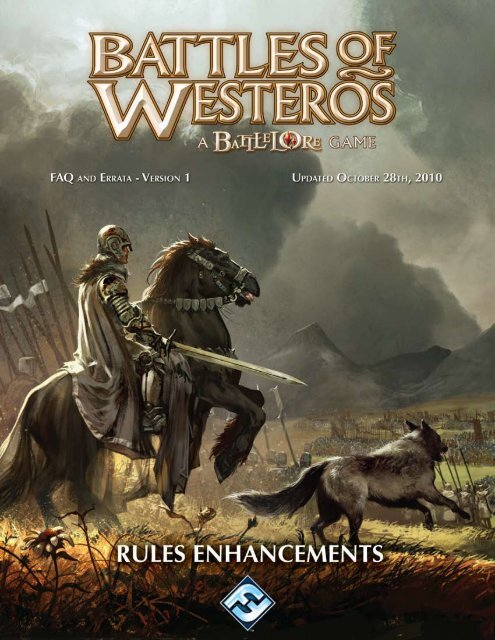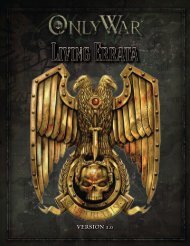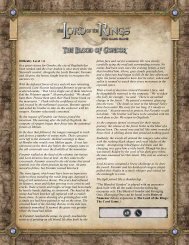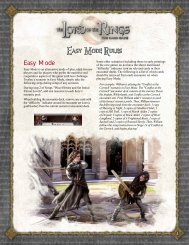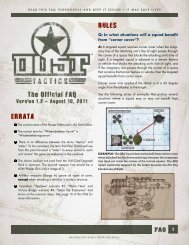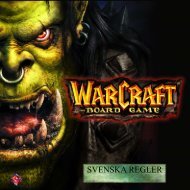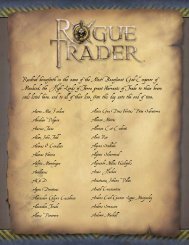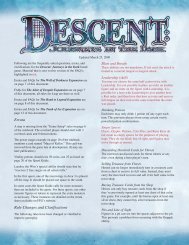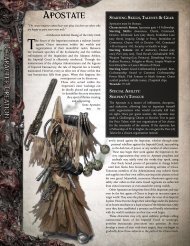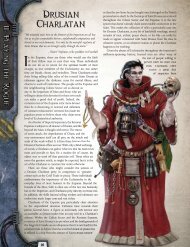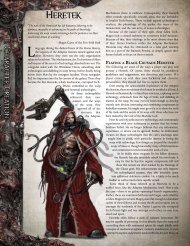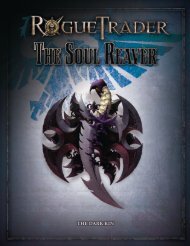Battles of Westeros FAQ - Fantasy Flight Games
Battles of Westeros FAQ - Fantasy Flight Games
Battles of Westeros FAQ - Fantasy Flight Games
You also want an ePaper? Increase the reach of your titles
YUMPU automatically turns print PDFs into web optimized ePapers that Google loves.
<strong>Battles</strong> <strong>of</strong> <strong>Westeros</strong> enhanced rules<br />
This document contains five optional rules and<br />
answers to frequently asked questions (starting<br />
on page 3). The optional rules maybe used on an<br />
individual basis at the discretion <strong>of</strong> both players<br />
to enhance <strong>Battles</strong> <strong>of</strong> <strong>Westeros</strong> gameplay.<br />
directional retreats<br />
For each Morale result rolled against it, a player’s<br />
unit must retreat one hex as follows<br />
If the hex in the opposite direction <strong>of</strong> the attack<br />
(called the primary retreat direction) is empty, the<br />
defending unit must take the full retreat in that<br />
direction. If that hex is occupied or impassable,<br />
the defending unit must retreat in the alternate<br />
retreat direction. The first hex in this direction is<br />
the hex adjacent to the primary retreat direction<br />
nearest the retreating unit’s owner’s board edge.<br />
When a unit is retreating, all <strong>of</strong> its retreats must<br />
be taken in the same direction. If at any point the<br />
defending unit can no longer retreat, it must take<br />
hits as described in the <strong>Battles</strong> <strong>of</strong> <strong>Westeros</strong> Core<br />
Set rulebook.<br />
For example, in the diagrams below, unit “A” represents<br />
the attacker while unit “T” represents the target unit.<br />
Additionally, unit “P” represents the primary retreat<br />
direction while unit “S” is the secondary retreat direction.<br />
It is important to note that if a retreating unit can retreat<br />
even one hex in the primary retreat direction, the<br />
secondary retreat direction is not even considered.<br />
Refer to diagram to the left.<br />
1
coordinated attacks<br />
Multiple units may melee attack the same unit<br />
simultaneously. When this occurs, one unit is<br />
declared as the lead unit while all other are<br />
supporting units. Supporting units give up their<br />
normal attack to add their attack dice minus one<br />
to the lead unit’s attack. All attack dice are rolled<br />
together. All units are activated normally.<br />
Only the lead unit (and its commander if it is a<br />
commander unit) can use his keyword abilities.<br />
If flanking units and non-flanking units are both<br />
used in a coordinated attack, no rerolls are rolled<br />
from the flanking unit (whether it is the lead or<br />
supporting unit). If ll units are flanking, rerolls occur<br />
normally.<br />
For example, two Winterfell Riders units are going to flank a<br />
Lannisport Guard unit. The Lannister player decides to coordinate<br />
attacks and Unit “A” is declared as the lead unit while unit “B”<br />
is declared as the supporting unit. Both are blue rank units.<br />
Therefore five dice are rolled for the attack (thr e from the lead<br />
unit and two from the supporting unit).<br />
Refer to the diagram to the left.<br />
any card to order 1 unit<br />
A player may discard any Leadership Card to order a<br />
single unit. A command token must still be placed on<br />
a commander and the ordered unit must be in that<br />
commander’s ZOC.<br />
reduced strength units<br />
Units that have lost at least half their strength (round up)<br />
are considered reduced strength units.<br />
Reduced strength units roll one less die during combat<br />
rolls.<br />
Reduced strength units can retreat a maximum <strong>of</strong><br />
two hexes. If forced to retreat beyond two hexes, the<br />
reduced strength unit takes hits as normal.<br />
WithdraWals<br />
After all ordered enemy units have moved, a<br />
player may choose to voluntarily withdraw<br />
any friendly units adjacent to an enemy unit<br />
ordered this turn. This happens before any new<br />
engagement tokens are placed on the game<br />
board. Withdrawing units must be active and<br />
adjacent to an enemy unit ordered this turn.<br />
1.To withdraw, a unit is moved into one <strong>of</strong> the<br />
two hexes toward its owner’s board edge and<br />
becomes inactive.<br />
2.If the withdrawing unit was engaged with<br />
another unit, the enemy unit may perform a<br />
parting blow as normal.<br />
3.The owner must then decrease his morale as<br />
follows: one if the withdrawing unit is <strong>of</strong> a rank<br />
lower than the enemy unit, by two if the ranks<br />
are equal, and by three if the moving unit is a<br />
high rank than the enemy unit.<br />
Multiple units may withdraw during a turn.<br />
2
For example, a red rank War Host <strong>of</strong> the North unit moves<br />
adjacent to two frail, green rank Westerlands Archers units.<br />
Immediately after moving, the Lannister player decides to<br />
withdraw his active archer unit (unit “A”) by withdrawing<br />
one hex toward his board edge and activating his unit.<br />
Since his unit is <strong>of</strong> a lower rank, he must decrease his<br />
morale by only one. If unit “B” was active, the Lannister<br />
player could also withdraw it. However, as an inactive unit,<br />
it does not have this po sibility.<br />
Refer to Diagram above.<br />
<strong>Battles</strong> <strong>of</strong> <strong>Westeros</strong> core set faQ &<br />
clarifications<br />
The following is a catalog <strong>of</strong> clarifications and<br />
corrections for the <strong>Battles</strong> <strong>of</strong> <strong>Westeros</strong> core set.<br />
Q. do terrain restrictions apply when retreating?<br />
A. Only impassable terrain is considered when retreating.<br />
Q. do terrain restrictions apply when<br />
pursuing?<br />
A.Yes.<br />
Q. can ranged units capture commanders?<br />
A.Yes.<br />
Q. does raising a kennelmaster’s rank apply<br />
benefits to its dogs <strong>of</strong> War attack?<br />
A.No.<br />
Q. can a leadership card be used to order less units<br />
than stated on the card?<br />
A.Yes. When ordering X units, you may always order up to<br />
X units (minimum 1).<br />
3
Q. can addam Marbrand’s (as “outrider<br />
commander”) move through terrain hexes with<br />
units in them?<br />
A.No.<br />
Q. When flanking with gregor’s (as “the<br />
Mountain”) unit ability, when do you reroll dice<br />
for flanking?<br />
A. Flank rerolls are done after adding the bonus dice from<br />
his unit ability.<br />
Q. are fire tokens replaced by devastation<br />
tokens?<br />
A.No. A devastation token is added to the same hex the<br />
fire is in.<br />
Q. When pursuing, can a unit use its second<br />
move to move back to its original hex and<br />
attack?<br />
A.No. The intent <strong>of</strong> the rules is that you may not end up in<br />
the same hex the original attack was from and still receive<br />
the extra attack.<br />
Q. What happens to a commander card after<br />
the corresponding commander is captured?<br />
A.It is returned to the box.<br />
Q. can kevan lannister use his unit ability if his unit<br />
does not have a legal target?<br />
A.Yes. He only needs to have the capability to attack.<br />
Q. can kevan lannister use his unit ability if his unit<br />
does not have a legal target?<br />
A.Yes. He only needs to have the capability to attack.<br />
<strong>Battles</strong> <strong>of</strong> <strong>Westeros</strong> errata<br />
The errata section covers changes and updates<br />
made after the initial printing <strong>of</strong> the game. Most<br />
<strong>of</strong> these have been made to the online rules<br />
found on our support page.<br />
In Battle #2 (“Paying the Piper”), Greatjon Umber<br />
should be blue rank.<br />
Maege Mormont’s commit ability should say “Flip this<br />
card prior to attacking with a unit Maege controls to<br />
have the controlled unit attack twice (instead <strong>of</strong> once)<br />
this turn” instead <strong>of</strong> round.<br />
Robb Stark’s “Young Wolf” Commander card<br />
commit ability should read :<br />
Robb gain the Dogs <strong>of</strong> War keyword<br />
during his attack this turn (even after movement).<br />
If this attack eliminates the target unit, do not flip<br />
this card to the back side.<br />
Rickard’s title in the Skirmish Setup cards should<br />
be “Lord <strong>of</strong> Karhold.”<br />
On page. 4, the plastic colors should be dark<br />
grey and light grey instead <strong>of</strong> grey and white.<br />
On page 14, the first section says: see “Status<br />
Conditions” on page 24 for more details.<br />
It should read page 25.<br />
On page 18, the last section says: When<br />
counting hexes, count all hexes that LOS is<br />
traced through except for the hex the attacking<br />
unit is in (see diagram on page 18).<br />
It should read page 19.<br />
page 19, first section, right column: (see<br />
“Attacking an Engaged Target” on page 21 for<br />
more details).<br />
“Flanking an Engaged Target” is meant<br />
here ...<br />
On page 20: “B. Causing Hits with Valor<br />
4
Symbols, Valor results are successes (hits)<br />
unless the attacking unit’s Order Table (see Unit<br />
Reference card) has the “no Valor hit” icon (see<br />
left).”<br />
Image was omitted so changed “left” to a<br />
page 11 reference.<br />
On page 20, final sentence on left column: Please see<br />
“Capturing Commanders” on page 21 for more details.<br />
It should read page 22.<br />
The colors under the page 24 results table for<br />
Dogs <strong>of</strong> War should be blue and not yellow.<br />
On page 27, Fire ... Special Rules: See “Fire” on<br />
page 24<br />
It should read page 25.<br />
On page 29, “13. Place Non-commander<br />
Units”: Here “terrain overlays” are addressed.<br />
Changed to “remaining units.”<br />
On page 29, the example at the top <strong>of</strong> the first<br />
column <strong>of</strong> page 29 is incorrect. The “Raid in the<br />
Riverlands” Skirmish Summary card is correct<br />
however.<br />
Skirmish Substitution Rule<br />
When assembling forces for a skirmish, a card<br />
may dictate that a player receives more troops <strong>of</strong><br />
a particular type than are available. If this is the<br />
case, the player may use a unit <strong>of</strong> the same class<br />
and rank whose House matches his Command<br />
Board.<br />
5


